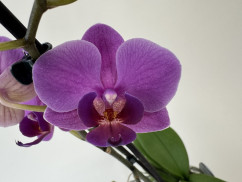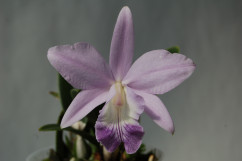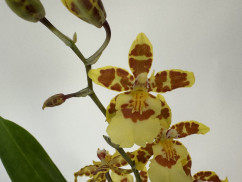Phalaenopsis
Many of the most popular orchid varieties have been produced from the genus Phalaenopsis.
Not only their variety of colors and shapes makes them so popular for everyone but above all their durability, flowering and easy care are outstanding. It is native to Indonesia and the Philippines and is also called Malayan Flower. In nature, they grow epiphytically on rocks and trees. The genus Phalaenopsis includes nearly 50 naturally occurring species. With no other orchid so much horticultural refinement was done, so that there are now well over 30,000 registered varieties.
Special orchid care instructions for Phalaenopsis (Butterfly orchid, Moth orchid)
They love a partially shaded and warm location. Phalaenopsis may be fertilized every 14 days throughout the year. A steady but not exaggerated irrigation is crucial. The roots should never be in the water for a long time. For good ventilation, add expanded clay or pebbles to the planter or peel. Tip: Cut off the stalk by about half when it has withered and within a few weeks the plant can drive a flower stem out of its sleeping eyes. Also a cooler location is good for the buds. Every 1 to 1.5 years a phalaenopsis should be repotted.
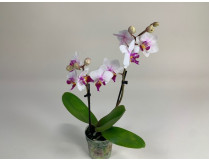
Doritaenopsis Alice (2 Rispen)
- flower season: whole year
- temperature: warm (20 - 24 °C
- Mehr Details

Doritaenopsis Anna-Larati Soekadi 'Rainbow'
- flower season: winter - spring
- temperature: warm (20 - 24 °C
- Mehr Details

Doritaenopsis Black Beauty (3 Rispen)
- flower season: whole year
- temperature: warm (20 - 24 °C
- Mehr Details

Doritaenopsis Confetti (3-4 Rispen)
- flower season: whole year
- temperature: warm (20 - 24 °C
- Mehr Details
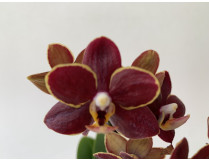
Doritaenopsis Esmee (2 Rispen)
- flower season: whole year
- temperature: warm (20 - 24 °C
- Mehr Details

Doritaenopsis Little Black Pearl (2 Rispen)
- flower season: whole year
- temperature: warm (20 - 24 °C
- Mehr Details

Doritaenopsis Liu's Cute Angel
- flower season: whole year
- temperature: warm (20 - 24 °C
- Mehr Details

Doritaenopsis Purple Beauty (3 Rispen)
- flower season: whole year
- temperature: warm (20 - 24 °C
- Mehr Details

Doritaenopsis Purple Gem
- flower season: summer - autumn
- temperature: warm (20 - 24 °C
- Mehr Details

Doritaenopsis Purple Gem 'Peloric'
- flower season: summer - autumn
- temperature: warm (20 - 24 °C
- Mehr Details
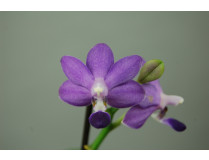
Doritaenopsis Purple Martin
- flower season: summer - autumn
- temperature: warm (20 - 24 °C
- Mehr Details
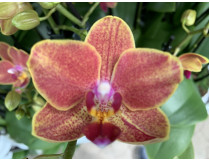
Doritaenopsis Sogo Allen (2 Rispen)
- flower season: whole year
- temperature: warm (20 - 24 °C
- Mehr Details

Doritaenopsis Sogo Bianca (2 Rispen)
- flower season: whole year
- temperature: warm (20 - 24 °C
- Mehr Details

Doritaenopsis Sogo Venis (2 Rispen)
- flower season: whole year
- temperature: warm (20 - 24 °C
- Mehr Details
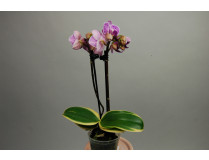
Doritaenopsis Sogo Vivien 'marginata' (2 Rispen)
- flower season: whole year
- temperature: warm (20 - 24 °C
- Mehr Details

Doritaenopsis Sogo Vivien 'marginata' (2 Rispen) -Sparset-
- flower season: whole year
- temperature: warm (20 - 24 °C
- Mehr Details

Doritaenopsis Sogo Vivien (2 Rispen)
- flower season: whole year
- temperature: warm (20 - 24 °C
- Mehr Details

Doritaenopsis Table Lemon (3-4 Rispen)
- flower season: whole year
- temperature: warm (20 - 24 °C
- Mehr Details

Doritaenopsis Table Masterpiece (4+ Rispen)
- flower season: whole year
- temperature: warm (20 - 24 °C
- Mehr Details

Doritaenopsis Table Mystery (3 Rispen)
- flower season: whole year
- temperature: warm (20 - 24 °C
- Mehr Details

Doritaenopsis Tying Black Beauty Bear (2 Rispen)
- flower season: whole year
- temperature: warm (20 - 24 °C
- Mehr Details

Doritaenopsis Tying Shin Melody 'Autumn Water'
- flower season: whole year
- temperature: warm (20 - 24 °C
- Mehr Details

Doritaenopsis Tzy Chiang 'Saphire'
- flower season: whole year
- temperature: warm (20 - 24 °C
- Mehr Details

Doritis pulcherrima 'alba'
- flower season: summer - autumn
- temperature: warm (20 - 24 °C
- Mehr Details

Doritis pulcherrima 'coerulea' x Phal. lindenii
- flower season: spring - summer
- temperature: warm (20 - 24 °C
- Mehr Details

Doritis pulcherrima 'marmorata'
- flower season: summer - autumn
- temperature: warm (20 - 24 °C
- Mehr Details

Doritis pulcherrima alba 'Peloric'
- flower season: summer - autumn
- temperature: warm (20 - 24 °C
- Mehr Details

Doritis pulcherrima minor
- flower season: summer - autumn
- temperature: warm (20 - 24 °C
- Mehr Details

Duft-Phalaenopsis Sortiment (2 versch. Duft-Phal.)
- flower season: whole year
- temperature: warm (20 - 24 °C
- Mehr Details
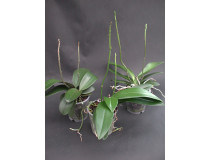
Grüner-Daumen-Sortiment (3 Pfl. im 12 cm Topf)
- flower season: whole year
- temperature: warm (20 - 24 °C
- Mehr Details

Grüner-Daumen-Sortiment (3 Pfl. im 9 cm Topf)
- flower season: whole year
- temperature: warm (20 - 24 °C
- Mehr Details

Paraphalaenopsis labukensis
- flower season: summer
- temperature: warm (20 - 24 °C
- Mehr Details

Paraphalaenopsis labukensis (Jgpfl.)
- flower season: summer
- temperature: warm (20 - 24 °C
- Mehr Details

Paraphalaenopsis labukensis x Vanda coerulescens
- flower season: winter - spring
- temperature: moderate - warm (18 - 22 °C)
- Mehr Details

Phalaenopsis (pulcherrima x appendiculata) x Anna Larati Soekardi
- flower season: spring - summer
- temperature: warm (20 - 24 °C
- Mehr Details

Phalaenopsis Aladin (2 Rispen)
- flower season: whole year
- temperature: warm (20 - 24 °C
- Mehr Details
Phalaenopsis
No orchid is found more frequently on our windowsills than the Phalaenopsis. Cultivated hybrids in particular, which are the result of targeted cross-breeding, are sold by the millions in Germany every year. It is no longer an exotic plant that only enthusiasts can afford to buy from specialised dealers. Nowadays, the Phalaenopsis, also known as the Malayan flower, is available at affordable prices. This is thanks to tissue culture, which allows orchids to be propagated in the laboratory with less effort and in large numbers. There are almost 50 naturally occurring Phalaenopsis species in the tropical rainforests of the Indies, Indonesia and the Philippines. Thanks to the high demand, new cultivated hybrids have been bred and commercialised over the centuries. We now have a choice of thousands of registered cultivated hybrids and hundreds more are added every year.
No other orchid is available in such diversity. There are tiny Phalaenopsis just a few centimetres tall and others that can reach over a metre in height. They can grow upright, arching or hanging. Their flowers, which come in a wide variety of shapes, patterns and colours, can be delicate or fleshy, small or up to 15 centimetres in size. Apart from their diversity, however, we love them above all because they are so wonderfully uncomplicated. Thanks to targeted horticultural breeding, it is now one of the most floriferous and at the same time most robust, easy-care and long-lasting orchids. Its stems can remain in bloom for weeks and months and even flower again afterwards. At the same time, it requires little care, making it an excellent gift for friends and acquaintances without green fingers.
In the 18th century, the flower shape of the Phalaenopsis reminded the botanist Carl von Linné of butterfly wings. This also gave it the name moth or butterfly orchid, from the Greek phalaina, meaning "moth" and opsis, meaning "sight", by which it is still known today. A group of Dendrobium orchids also has flowers with this typical butterfly shape and is therefore called Dendrobium Phalaenopsis. In nature, Phalaenopsis, like most orchids, reproduces with the help of insects that pollinate its flowers so that seeds mature to produce the next generation. However, there is something special about the Phalaenopsis genus: the Polychilos subgenus has developed a unique mechanism to support the ripening of its pistils in a special way. Once an insect has fertilised a Polychilos flower, it does not wither, as is the case with other plants, but undergoes a metamorphosis into a smaller green flower. This is able to photosynthesise and thus contribute to the energy requirements of seed maturation. This gives them an advantage over other species when it comes to reproduction.
Phalaenopsis is native to the rainforests of South-East Asia. However, the ongoing destruction of nature is threatening the natural occurrence of orchids there. In order to protect the natural populations, the trade in Phalaenopsis from South-East Asia is strictly regulated. Even if they appear to be something special, nobody should bring wild orchids back from holiday and never buy Phalaenopsis from South East Asia, but always from a breeder in Germany.
Phalaenopsis care
In our flat, at heated temperatures of at least 18°C at night and a maximum of 25°C during the day (extreme heat development in summer is tolerated). At a humidity of 40% and 60% it feels just as comfortable as we do. Window sills are a suitable location. This location suits them very well as, like all orchids, they are "children of light" by nature. However, they should not be exposed to direct sunlight during the light-rich period, as the leaves and flowers can heat up and burn.
From October to March, Phalaenopsis receive full light, i.e. no shading whatsoever. From March to October, we provide so-called partial shade, i.e. do not expose the plant to direct sunlight. Window sills facing north generally require no shading. Those facing east require little shade. They are actually the best locations of all. Places in the south, especially in the west due to long-lasting afternoon sun, require special attention. The lack of shade here can also make it particularly hot.
Orchids in general, including Phalaenopsis, are sensitive to stagnant moisture. For this reason, the following watering rhythm is recommended: watering once a week with room temperature, stale tap water, preferably rainwater. Dipping the pot for approx. 2 to 3 seconds and then letting it drip off is also extremely suitable. Any watering should only be done in the early hours of the morning so that the plants have dried out by night.
Orchids are so-called "weak feeders", i.e. they get by with little food. Add 0.5 grams = ½ ml of an orchid fertiliser (not a normal flower fertiliser) to the water every 14 days, less often in winter (every 2nd watering), which is completely sufficient. Phalaenopsis are an exception. They are also fertilised regularly in the winter months. They will thank you with regular, long-lasting flowers.
After withering, the flower stems can even flower again. To do this, shorten them so that at least three eyes remain. The so-called dormant eyes can then sprout and blossom.

 ... to newsletter subscription
... to newsletter subscription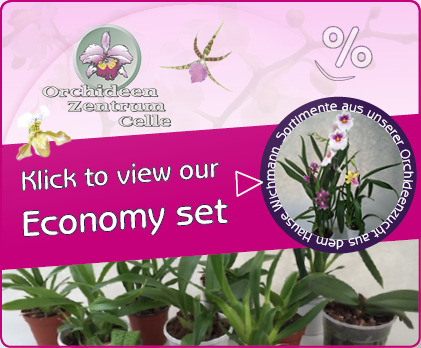 ... to see all economy sets
... to see all economy sets










